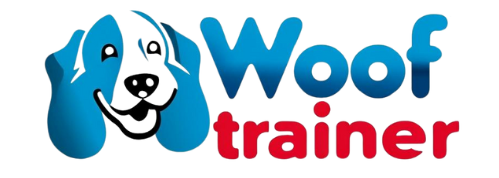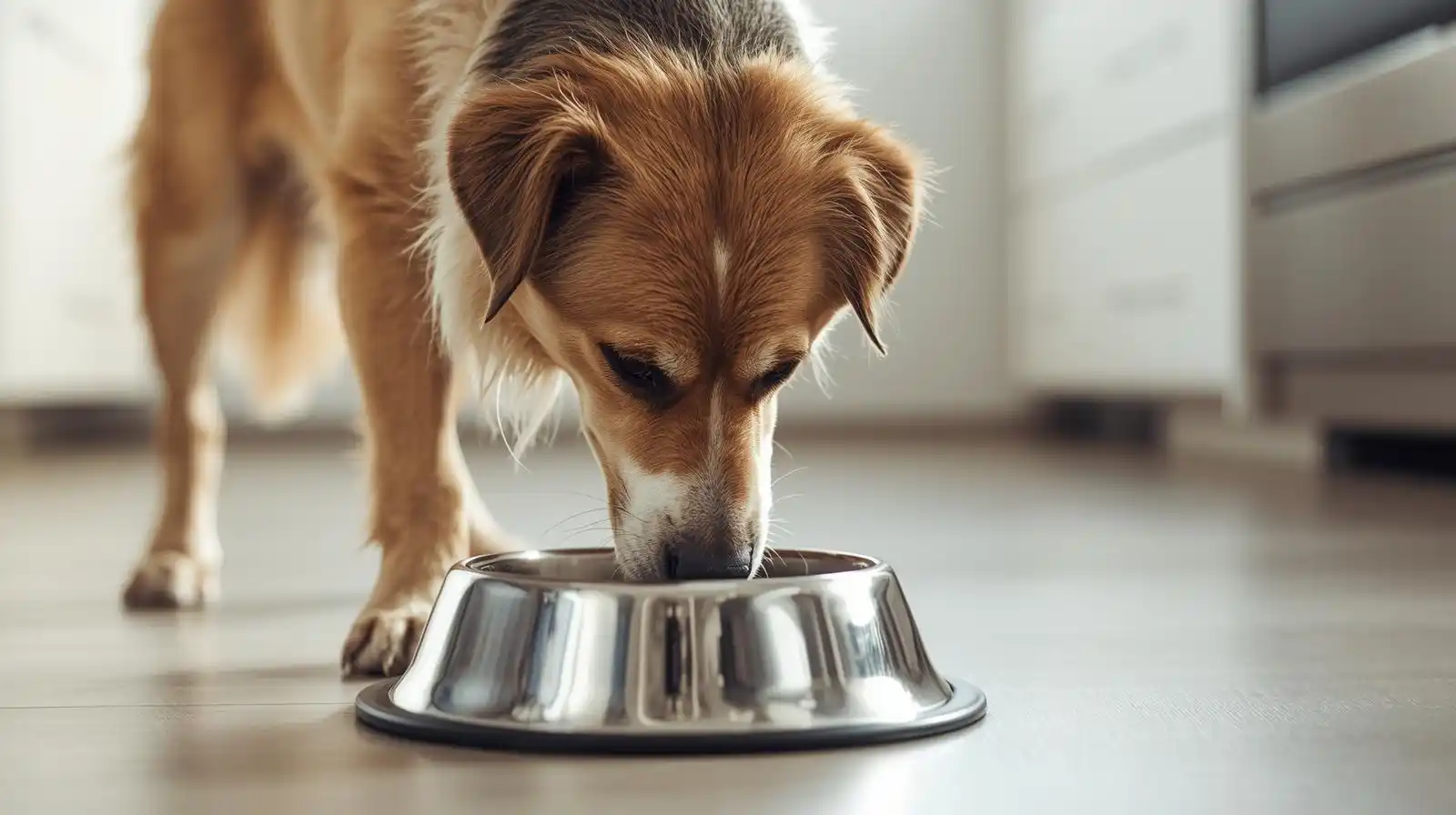When choosing a dog bowl, the material matters just as much as size or shape. Among bowl materials, stainless steel dog bowls stand out for many reasons—durability, hygiene, safety—but there are trade-offs to consider. This guide helps dog owners make the best decision for their pet’s health, safety, and day-to-day feeding routine.
What is Stainless Steel & Why It’s Used
Stainless steel is a metal alloy (iron, chromium, sometimes nickel and others) that has inherent resistance to corrosion because chromium forms a “passive layer” of oxide on the surface. In dog bowls, commonly used grades include 304 stainless steel (also called 18/8) or food-grade “200-series” / “300-series.” These are chosen because they are:
- Non-porous → bacteria have fewer places to hide.
- Rust-resistant → less likely to degrade outdoors or from moisture.
- Durable → resists chewing, denting, cracking.
These features make stainless steel suitable for feeding both wet and dry food, for water, indoors and outdoors.
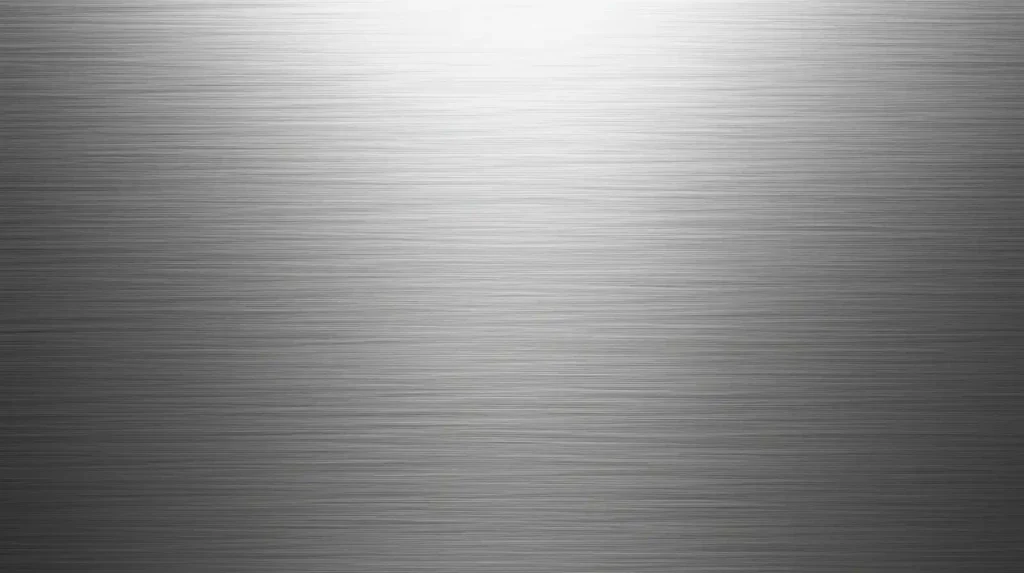
Benefits of Stainless Steel Dog Bowls
For dog owners concerned about health, daily feeding, and safety, stainless steel brings a strong list of benefits:
- Hygiene: Smooth, non-porous surfaces are easier to clean and sanitize. They don’t trap food particles or oils like plastic might.
- Durability: Stainless steel resists breaking, chipping or cracking. It can handle rough play or being knocked around.
- Chemical safety: Good food-grade stainless steel doesn’t leach harmful chemicals; unlike some plastics which may release BPA or phthalates.
- Dishwasher safe: Many stainless steel bowls can go in the dishwasher, which helps sanitize at high temperature.
- Rust and stain resistance: Proper stainless steel resists rust and staining from moisture or food acids.
- Cost-effectiveness: Because of longevity, even a higher quality stainless steel bowl often ends up costing less per year than frequently replaced cheaper plastic bowls.
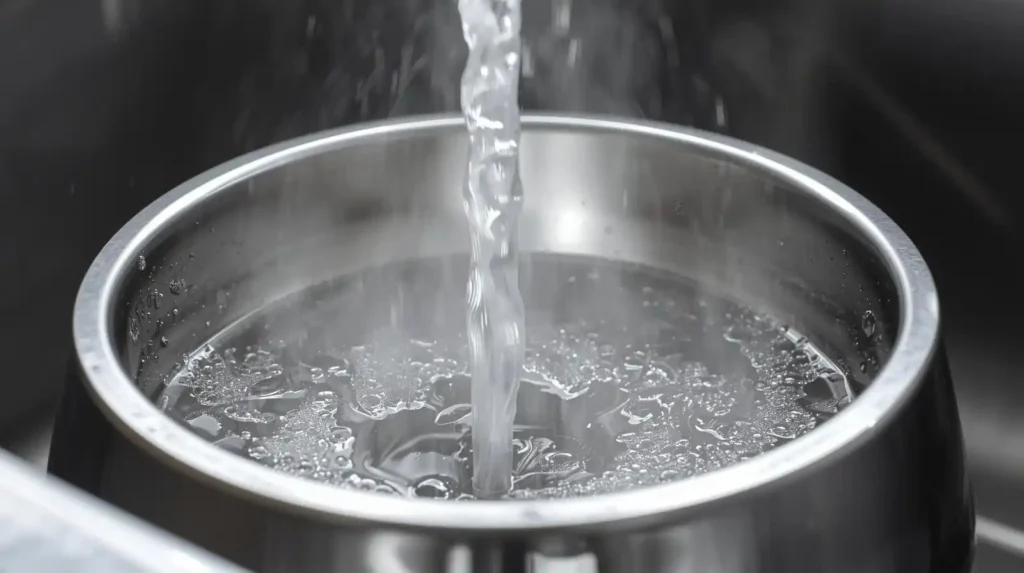
Potential Drawbacks and How to Mitigate Them
Even with many advantages, stainless steel dog bowls have some downsides. Knowing these, and how to reduce their impact, helps make them even more suitable.
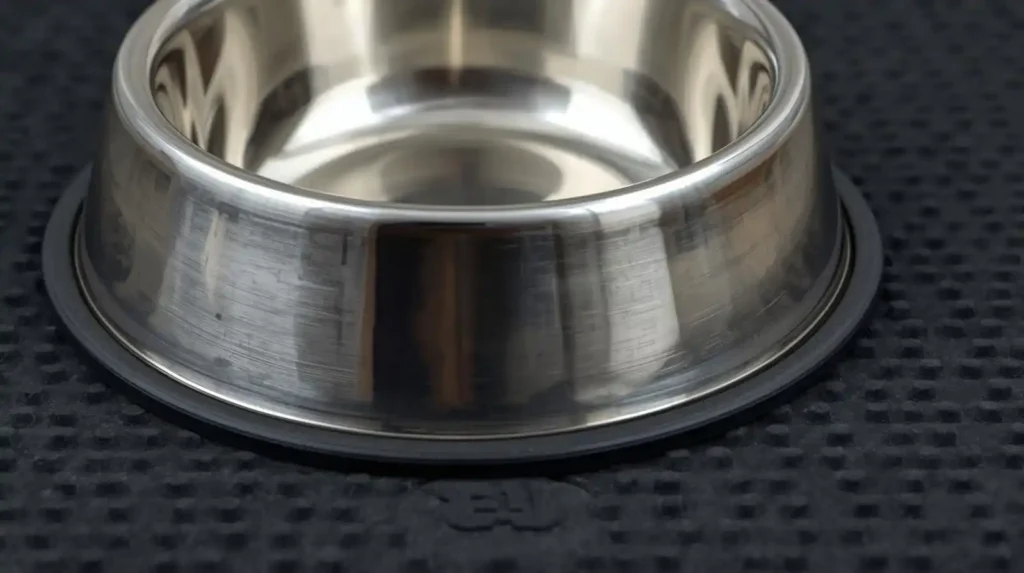
| Issue | What the concern is | How to reduce or avoid it |
|---|---|---|
| Noise & Clanking | On a hard floor, bowls can make loud sounds when dog eats, nudges them, or pushes them. | Use bowls with non-slip rubber bases; place them on a mat; choose thicker gauge steel to reduce vibration. |
| Lightweight sliding | A lightweight stainless steel bowl may shift easily, spill water or food. | Non-skid base, rubber ring on bottom, or elevated stand can help. |
| Temperature sensitivity | Stainless steel can get very cold or hot depending on environment, making water too cold outdoors, or bowl hot if in sun. | Don’t leave bowls in direct sun; bring indoors in cold weather; insulated designs or double-wall models may help. |
| Appearance / Scratches | Over time may get dented or scratched, which can look worn. Deep scratches may trap bacteria. | Inspect regularly; avoid abrasive cleaning tools; replace when surface is badly scored. |
| Metallic taste / smell | Some dogs dislike metallic odor or taste, especially if water sits for long. | Clean frequently; rinse well; replace water often; choose higher quality steel with smoother finishes. |
What to Look for When Buying a Stainless Steel Dog Bowl
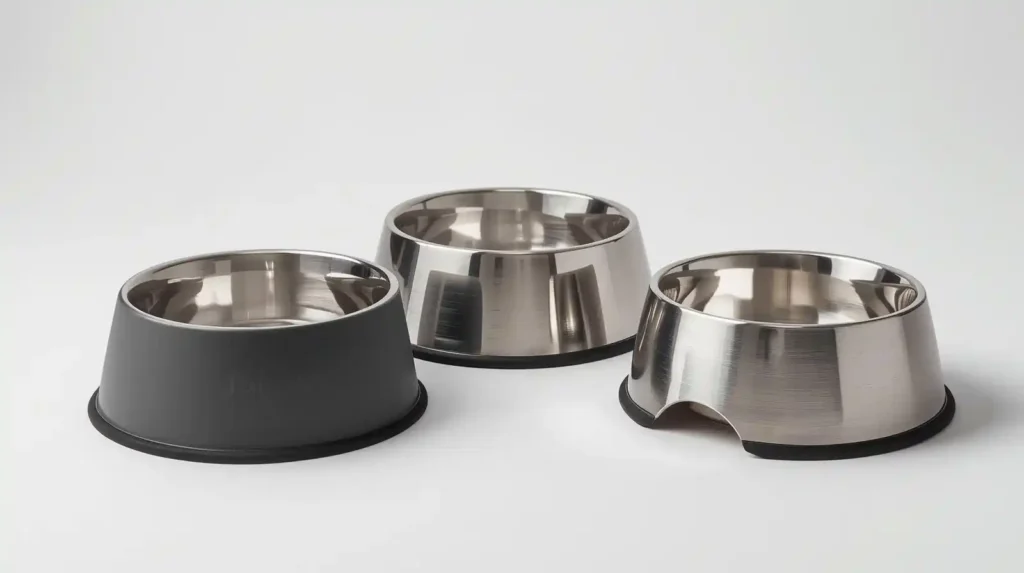
If a dog owner decides to buy a stainless steel dog bowl, here’s what to check for to ensure the best health, safety, and durability.
- Grade of stainless steel: Look for “304” or “18/8” or at least clearly food-grade 200/300 series. Avoid vague labels.
- Thickness / gauge: Thicker steel resists dents, warping. Thin sheets may deform or pinch.
- Base design: Non-skid, rubber rim, weighted bottom, or use with feeding mat to reduce sliding.
- Size & shape: Appropriate capacity for your dog’s size; shallow vs deep bowls depending on breed (long snouts, or ears that drag).
- Finish and polish: Smooth finish, minimal exposed seams or welds. Matte vs mirrored finish preferences.
- Dishwasher safe and manufacturer instructions: Prefer bowls that are explicitly labelled dishwasher safe. Look for care instructions to avoid damage.
- Certifications and safety testing: Some bowls are tested for lead, heavy metals; avoid glazes or coatings that may chip.
Daily Use, Cleaning & Maintenance
Having the right bowl is only part of good feeding practice. How it is used, cleaned, and maintained is crucial for your pet’s safety and health.
Cleaning Frequency
- Wash food bowls after each meal, especially if feeding wet food.
- Water bowls should be rinsed daily and cleaned thoroughly at least every day, especially if outdoors. (American Kennel Club)
Cleaning Methods
- By hand: Use hot water, mild dish soap, and a soft, scratch-free sponge. Avoid steel wool or harsh scouring pads. Rinse well.
- Dishwasher: If the bowl is dishwasher-safe, use a high-heat cycle. The heat and detergent help kill bacteria.
- Deep cleaning / sanitizing: Once a week or as needed, soak in a mild vinegar solution, or use pet-safe sanitizers per manufacturer directions to break down biofilm.
Maintain and Inspect
- Check for dents, scratches, or rust spots. Deep scratches can harbor bacteria. Replace bowls that are severely damaged.
- Avoid letting water sit long periods—standing water can accumulate bacteria even in stainless steel.
- Dry the bowl after cleaning; moisture left behind can lead to mineral stains or spots (hard water) or promote growth of microbes.
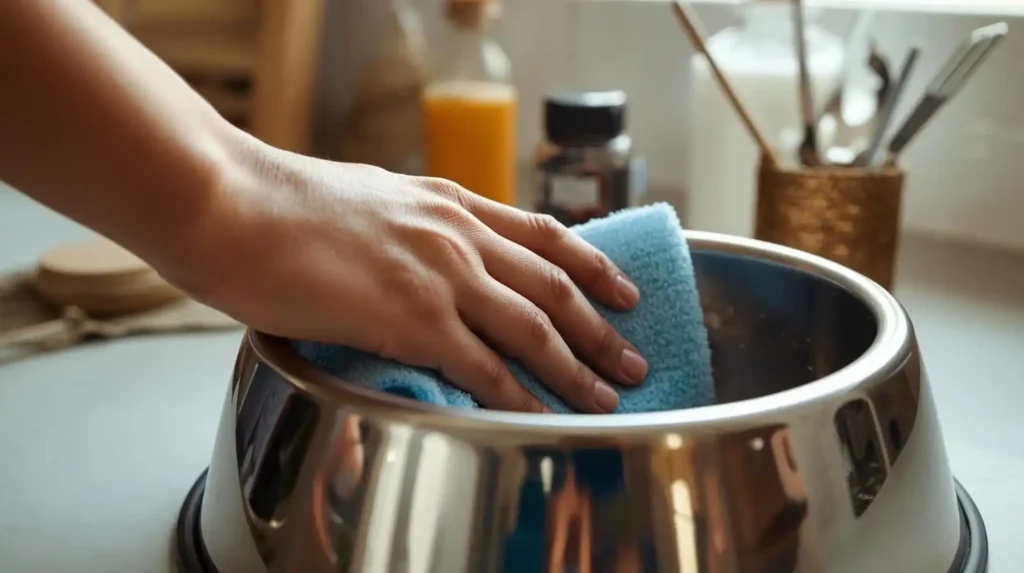
How Stainless Steel Compares with Plastic, Ceramic.
To decide if stainless steel is right, it helps to compare it directly with other bowl materials. This can clarify trade-offs.
-
Plastic: Generally inexpensive and lightweight. However, plastic scratches easily, can harbor bacteria in scratch lines, may contain harmful chemicals, and may absorb odors. Most experts and veterinarians consider stainless steel to be safer and more durable. (Seaport Animal Hospital)
-
Ceramic: Offers aesthetic appeal, weight (less movement), and decorative variety. But ceramic may chip or crack; glaze quality matters (lead-free glaze required). Poorly glazed or cracked ceramic surfaces can hide bacteria. Stainless steel tends to win in rugged durability and hygiene.
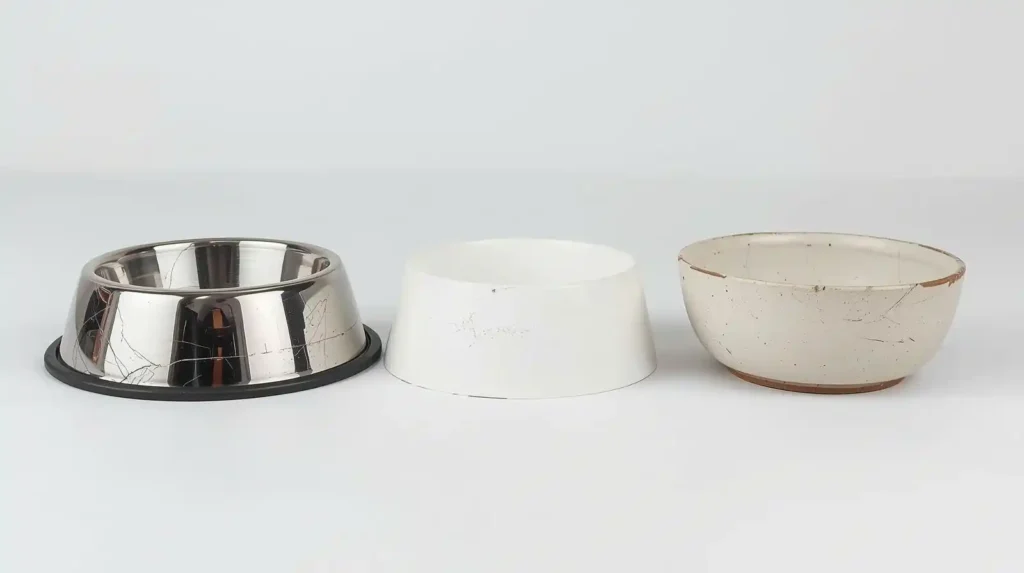
For deeper reading and detailed side-by-side comparison, see Stainless Steel vs Plastic and Ceramic Dog Bowls: An In-Depth Comparison.
Are Stainless Steel Dog Bowls Safe for Your Pet?
Yes—with the right bowl and care, stainless steel dog bowls are very safe. Here are the safety aspects to consider:
- Non-leaching: Food-grade stainless steel does not leach toxic chemicals into food or water.
- Allergies and sensitivities: Dogs with sensitive skin or metal allergies are rarely affected by stainless steel (though individual cases exist). Stainless steel is hypo-allergenic in most cases.
- Bacterial control: Because surfaces are non-porous, regular cleaning breaks down biofilm and prevents pathogens (E. coli, salmonella etc.) from proliferating. Researchers find that bowls with more frequent cleaning have far less bacterial load.
- Avoiding injury: Use bowls without sharp edges; avoid coatings or embellishments that can chip.
By following best practices for cleaning and material selection, stainless steel dog bowls can offer a high level of safety for daily feeding.
Use Cases & Practical Tips
To help you pick and use stainless steel bowls in real life, here are some stories and examples from dog owners, plus recommendations:
- For puppies / chewers: A friend’s young Labrador kept biting its bowl. When they switched to a thick-gauge stainless steel bowl with a rubber base, it held up far better than plastic or thin ceramic.
- For outdoor feeding: Stainless steel handles rain, sun, and dirt much better than ceramic that may crack in freezing weather or plastic that warps.
- Travel or portability: Steel bowls are less convenient to pack because of weight, but collapsible or nesting stainless steel designs do exist. Some are combined with silicone or rubber.
- Multiple pets: It’s helpful to have several bowls so one is always clean and standing by. Stainless steel’s durability makes this affordable long-term.
Also, if you live in cold climates or have outdoor sources for water, you might consider guidance from resources like Freeze-Proof Kennel Water Systems: Complete Guide to protect your water bowls and systems from freezing.
Frequently Asked Questions (FAQ)
-
How often should one clean a stainless steel dog bowl?
Dog food bowls (especially with wet food) should be washed after each meal. Water bowls should be rinsed daily and cleaned thoroughly at least once a day. -
Can stainless steel bowls rust or corrode?
High-quality food‐grade stainless steel (304/18-8) resists rust. Rust is more likely if the bowl is low quality, exposed to harsh chemicals, or left wet for long periods. -
Are stainless steel bowls safe for dogs with allergies?
Yes, generally. Stainless steel is one of the least reactive materials. If a dog has a specific metal allergy (rare), testing might be needed, but most dogs tolerate stainless steel well. -
Is dishwasher safe always fine? Or can the dishwasher damage the bowl?
Stainless steel bowls labeled as dishwasher safe can go in. But repeated cycles with harsh detergents or contact with other reactive metals may cause discoloration or scratches. Use top rack or spaced placement. -
Does the finish matter (matte vs shiny / polished)?
Finish matters for cleaning and smell. Shiny, smooth finishes tend to resist staining and buildup better. Matte or brushed finishes may hide scratches but might trap more grime in micro-scratches. -
What grade of stainless steel should I choose?
Aim for 304 / 18/8 food-grade stainless steel. 200 series is sometimes used but may not be as corrosion-resistant. Always buy from reputable manufacturers. -
Should I replace stainless steel bowls? If so, how often?
Yes, when damage is visible: deep scratches, warping, rust, or any place where bacteria may hide. For many owners, a good stainless steel bowl lasts several years; subjective based on use. -
Are insulated or elevated stainless steel bowls better for certain dogs?
Elevated bowls may help large breeds or dogs with joint issues by reducing strain on necks. Insulated or double-wall designs help keep water cooler or protect from rapid temperature changes. -
Do stainless steel bowls make food colder or hotter than other materials?
Yes, metal conducts heat fast. Dry or wet food may cool faster; water outdoors may get cold quickly. Keep in moderate temperature, avoid direct sun exposure, and use insulating mats if required.
Summary
For dog owners seeking the best for their pets, a well-chosen stainless steel dog bowl offers excellent benefits: hygiene, durability, safety, and long-term value. While there are some downsides—noise, temperature sensitivity, potential for scratches—these can be minimized with smart choices and careful maintenance. Choosing food-grade stainless steel, ensuring proper cleaning & replacing bowls when needed, makes stainless steel among the best material options for your dog’s daily feeding routine.
